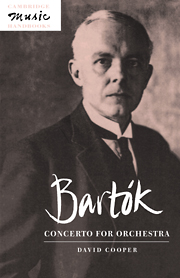1 - Introduction
Published online by Cambridge University Press: 24 November 2009
Summary
… this other music of today, the music of Bartók! Chaos in place of Cosmos, confusion in place of order, scattered clouds of aural sensation in place of clarity and shape, fortuitous proportions and a renunciation of architecture in place of structure and controlled development. Yet this too was masterly. Even beautiful, moving, sublime, wonderfully gifted! … And all the more beautiful and irresistible by virtue of its being precisely the music of our time: an expression of our experience, our view of life, our strengths and our weaknesses. It expresses us and our questionable life-styles while also affirming us. Like us, this music knows the beauty of dissonance and pain; the many scales of fractional and varied tones, the overthrow and relativization of morals and established modes of thought. No less than us does it know the yearning for the paradises of order and security, of logic and of harmony.
Hermann Hesse's diary-entry of 15 May 1955, in response to a radio broadcast that morning of the Concerto for Orchestra and a concerto grosso by Handel, captures the essence of Bartók's music, with its precarious tightrope balance between urban art music and rural popular music, tonality and atonality, chaos and order. The conventional musical analyst will probably reject Hesse's opinions of the structural fortuity of the work as the value judgement of an amateur. Yet Hesse's assessment avoids the tendency to normalize Bartók's music which is so prevalent among professional commentators today, albeit according to a number of different systems of analysis.
- Type
- Chapter
- Information
- Bartók: Concerto for Orchestra , pp. 1 - 2Publisher: Cambridge University PressPrint publication year: 1996

